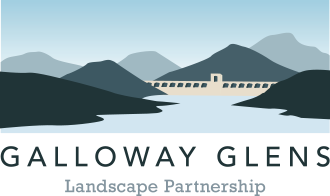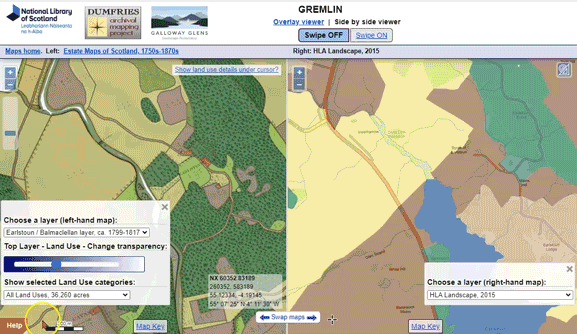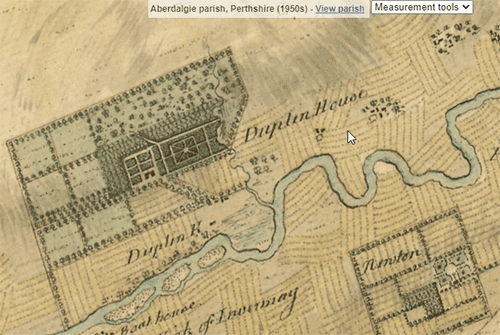GREMLIN Map Viewers - Help
Introduction
These map viewers allow maps and land use to be compared over the last 200 years for the Earlstoun and Holm Estates in the parishes of Balmaclellan, Dalry, and Kells in the Glenkens, Galloway.
GREMLIN - the Glenkens Rectified Estate Mapping and Land use Information Network - began in March 2023, with three main aims:
- to georeference and seam together 44 estate maps relating to the Earlstoun and Holm Estates
- to trace the land use from these estate maps, recording the land use parcels as shown on the maps
- to present these layers of estate mapping and land use information in online viewers
This is a collaborative project between the Dumfries Archival Mapping Project, the Galloway Glens Landscape Partnership, and the National Library of Scotland. View Project GREMLIN press release.
- Download dataset
- Read about Land Use
Overlay viewer
The following sections describe the main tools and functions on the map viewer screens.
Lower left
Top right
Lower right (Overlay viewer only)
Side by Side viewer
In the Side by Side viewer, by default, the estate maps (1799-1817) appear on the left, and the Historic Landscape Assessment (2015) layer appears on the right. ( Read further details about these layers ).

If you click on the 'Show land use details under cursor?' link to the upper right (left-hand map), when you hover your mouse over either the estate map layer or the HLA Layer, the land use in 1799-1815 and in 2015 of the particular land parcel you are hovering over appears to the upper right.
Map Layers
There are 17 map layers in the viewers, dating from Roy Military Survey (1752-55) to the present day. The main Ordnance Survey editions of mapping at Six-Inch to the mile are available, as are various thematic layers, including the 1930s Land Utilisation Survey. Modern day layers of satellite imagery, topographic mapping and LiDAR are also available. Read further details on the main layers showing land use.
View land use information (lower left)
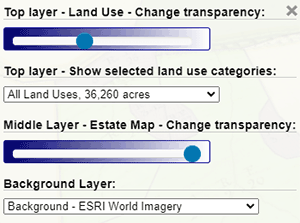
The land use from the estate maps (1799-1817) has been traced, and it is presented online as a coloured overlay. You can Change transparency of Land Use layer with a slider to the lower left-hand side. It is also possible to Show selected land use categories with the drop-down list to the lower left, to just display a particular land use type.
If you click on the 'Show land use details under cursor?' link to the upper right, when you hover your mouse over the estate map layer, the land use, farm and acreage/hectarage of the particular land parcel you are hovering over appears to the upper right.
Read further details about land use.
Add Layer (lower left)
Add your own layer of information to the map, to view and edit it. Or create your own layer.
If you click/tap on the 'Add Layer' icon ![]() , to the lower left of the screen, then an 'Add your own layer' panel opens:
, to the lower left of the screen, then an 'Add your own layer' panel opens:
- Choose file format: KML, GPX, or GeoJSON
- Choose file source: browse to find a local file, or paste in a URL for an online file
- Click/tap on the IMPORT button to add your layer. The map should centre on your layer's extents.
For layers with attributes, you can click/tap on the layer to bring up a popup box showing the specific attributes. You can edit the layer with the Add or Edit Features tools ![]() (top right). To remove the layer, click/tap on the Remove top layer link in the lower centre of the screen.
(top right). To remove the layer, click/tap on the Remove top layer link in the lower centre of the screen.
Printing and Image Export/Download (lower left)
If you click/tap on the print icon ![]() , to the lower left of the screen, then a print panel opens with various options:
, to the lower left of the screen, then a print panel opens with various options:
- Portrait / landscape orientation
- Page size – A4 to A0
- Margin – 0 to 10 mm
- Scale – 1:500 to 1:1,000,000 - set an exact scale for your map
- North Arrow – off or on
- Scale bar – off or on
At this stage you can also pan/drag or zoom the map image to make sure its covering exactly the right area of interest.
You can then save the image in various formats – JPEG, PNG, PDF, or copy the image to clipboard. It is also possible to print the map directly to a printer.
If you wish to obtain a georeferenced map export, please consult our Re-using georeferenced maps guide.
Go to GREMLIN Overlay viewer.
Show land use under cursor (top right)

If you click on the 'Show land use details under cursor?' link to the upper right, when you hover your mouse over the estate map layer, the land use, farm and acreage/hectarage of the particular land parcel you are hovering over appears to the upper right.
Add or Edit Features (top right)
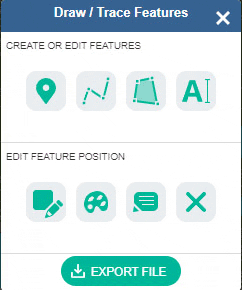
If you select the Draw / Trace Features button ![]() to the upper right, you can draw or trace new features, edit layers, and print or export the results.
to the upper right, you can draw or trace new features, edit layers, and print or export the results.
- You can Create Features, annotating the map, or tracing features. You can add points, lines, polygons or text.
- You can Edit Features, alter feature position, feature style (colour, line and fill properties), or feature text. You can also Delete Features
- You can Print or Save an image of your sketch or tracing at any time using the Print button

- You can Export your drawing as a KML (Keyhole Markup Language), GPX, or GeoJSON file, saving the geographic coordinates, features and styles of your drawing.
- The KML format includes feature style tags natively, so styles (such as line colour and thickness, or polygon fill colours) can be saved and shared more easily. KML files can also be opened in Google Earth.
- For GeoSJON and GPX files, the styles and attributes are recorded in extensions: GeoJSON simplestyle or GPX Exchange Format.
- The default GeoJSON export projection is WGS84 (EPSG:4326) with latitude and longitude coordinates, but you can also export GeoJSON in the British National Grid (EPSG:27700) with Eastings and Northings in metres by choosing the GeoJSON (BNG) option.
When tracing features such as lines or polygons, a double-click finishes the drawing, so to add points close together, zoom in (with the mouse wheel or pinch zoom) to do this. If you accidentally finish drawing too soon, you can edit the feature to add or alter points.
The downloaded files can be brought back into the Georeferenced Maps viewer using the Add Layer button ![]() , for further editing. You can also open them in any text editor, or open and edit them in QGIS or ArcGIS Online. Read our guide on Opening map datasets in QGIS.
, for further editing. You can also open them in any text editor, or open and edit them in QGIS or ArcGIS Online. Read our guide on Opening map datasets in QGIS.
Go to GREMLIN Overlay viewer.
Measurement tools (top right)
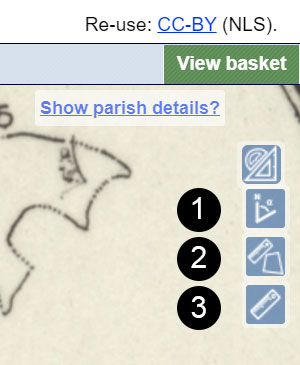
These tools, to the upper right, allow you to measure:
- Bearing or Azimuth - in degrees from true North
- Area - in square kilometres and square miles / square metres and square feet
- Distance - in kilometres and miles / metres and feet
Click or tap on the buttons to toggle the measurement functions on or off. Once selected, click or tap to add points on your route - the current bearing, distance or area is given. Single-click with a mouse or tap to stop and finalise the bearing or distance measurement; double-click with a mouse or double-tap to finalise the area measurement.
Rotation (top right)
Hold the [Alt] and [Shift] keys down, and drag with your cursor, or pinch with two fingers on a touch screen to rotate the map. Click/tap on the blue arrow to the upper right, or refresh the page to return to the default rotation.
Go to GREMLIN Overlay viewer.
Show height - lower right. (Overlay viewer only)
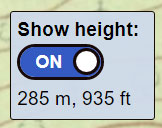
If you switch the 'Show height' button (lower right) to ON, the approximate height of your cursor location is shown in metres and feet. This height data is obtained via the Géoportail Altimetrie Web Map Service, based on elevation information from the N.A.S.A. Shuttle Radar Topography Mission (SRTM3) Global Digital Terrain Model. These heights generally have a horizontal accuracy of 30 x 30 metres.
This height information may give a general idea of heights when looking at maps without surface heights, bench marks, or contours, but it is likely to be less accurate than the heights that are shown on more detailed, larger-scale mapping (eg. at 1:10,000 scale or larger). The height information may be helpful in giving a general idea of the direction of slope and approximate elevation where this information is lacking from the map you are looking at.
Elevation Profile - lower right (Overlay viewer only)
For any location in the Overlay viewer, you can trace a route on the map to view its elevation profile:
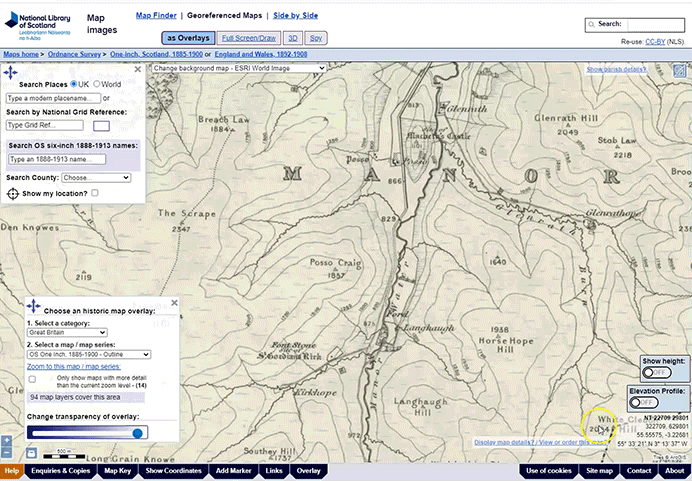


- Switch the 'Elevation Profile' button (lower right) to ON.
- Click or tap a line or route on the map.
- Double-click / Double-tap to finish, and an Elevation Profile popup box should appear showing the elevation profile for your line.
TIP: If you need to click points along your route that are close together, zoom in (with the mouse wheel) so that single clicks are not treated like a double-click, finishing your profile route too soon.
The elevation profile is calculated using MapTiler Terrain-RGB data, with elevation information encoded into the RGB values for each pixel. The horizontal resolution of the elevation data is around 30x30 metres. The elevation information is based on present-day terrain, and may sometimes be different from the former terrain at the time of the historic map overlay layers.
Show estate map - lower right (Overlay viewer only)

If you click the 'Show estate map' link to the lower right, a new tab opens showing the original, ungeoreferenced estate map, for the estate map shown in the centre of the screen. This may be useful for viewing the original estate map, as well as non-map details such as the land use schedules and title cartouche, etc., which have been cropped from the georeferenced estate map layer.
Go to GREMLIN Overlay viewer.
Dataset Download
We have made available the GREMLIN estate map land use layer for onward re-use.
The following information was recorded about each land parcel:
| Field Name | Description |
|---|---|
| ID | The unique ID for the land parcel, generated automatically as a sequential number |
| Landuse | The land use as recorded on the estate maps - see Land Use page for further information |
| Land_use | The land use standardised for queries, and with underscores between separate words, eg. "Enclosed_pasture" |
| Farm | The farm as shown on the estate maps |
| Acreage | Area of the land parcel in modern acres - see Land Use page for further information |
| Hectarage | Area of the land parcel in hectares |
The dataset is available in CSV and GeoJSON formats:
These datasets were taken on 2 July 2023.
These files use UTF-8 for character encoding. Each of these links will open a file that can be saved locally. For the GeoJSON file, please change the file extension from *.js to *.geojson. Please also look at our guide on Opening Map Datasets in QGIS for advice on how to use the CSV and GeoJSON files within the free QGIS desktop software.
Background mapping
You can also bring any of the background layers shown in this viewer into other software, following our Re-using georeferenced maps guide.
This allows the background mapping to be added into QGIS, ArcGIS, or geojson.io so that the GREMLIN estate map land use layer can be seen on top of a background layer of other historic maps.
We would welcome information on any mistakes, or suggestions for improvements. Please contact us at maps@nls.uk.
Go to GREMLIN Home Page or read Land Use information.


